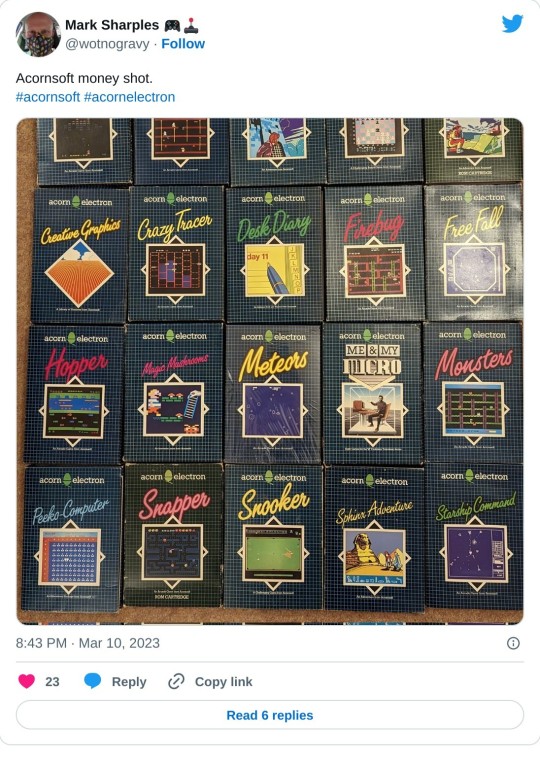#ACORNSOFT
Text
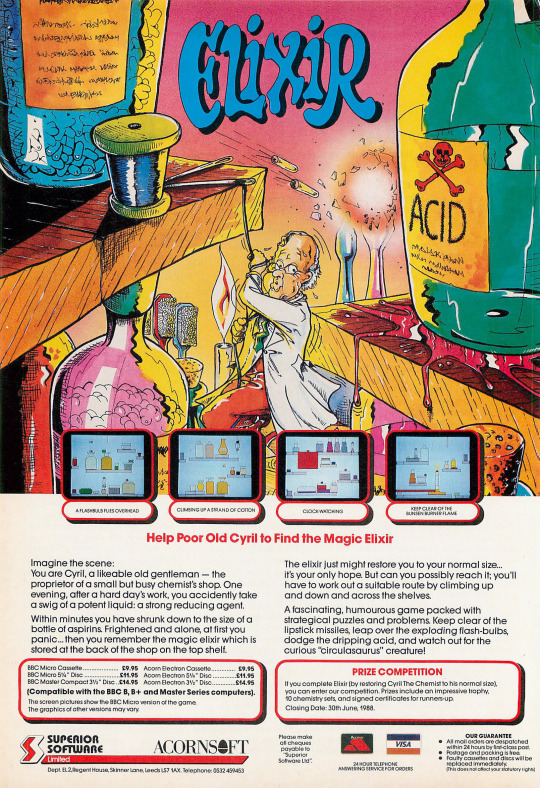
UK 1987
11 notes
·
View notes
Photo
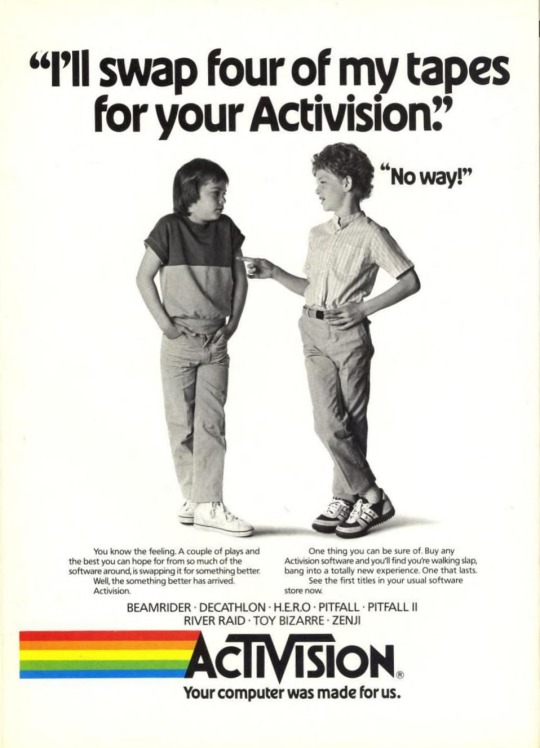

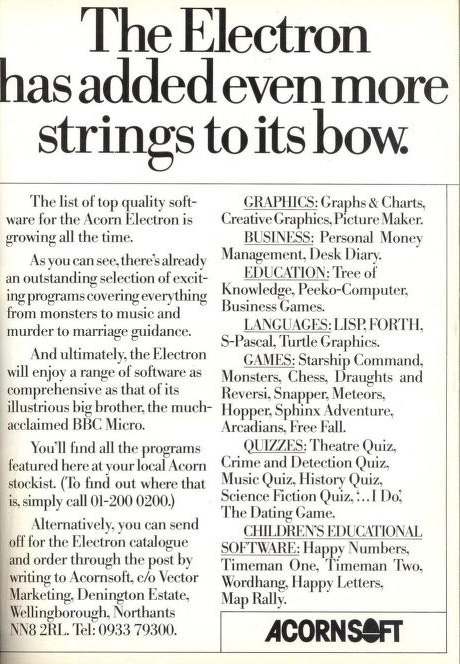
Ads from Big K magazine, September 1984.
0 notes
Text
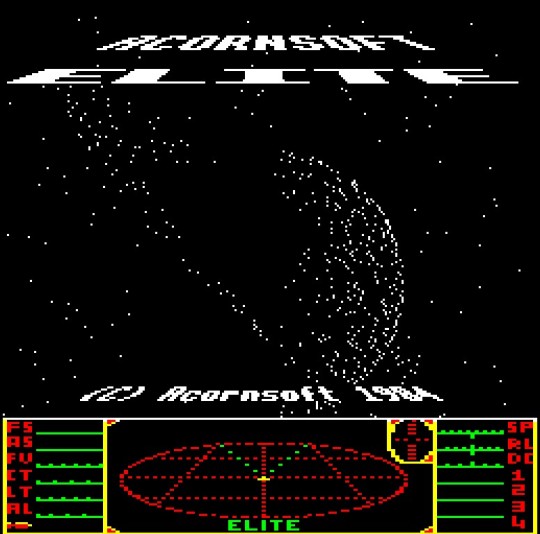
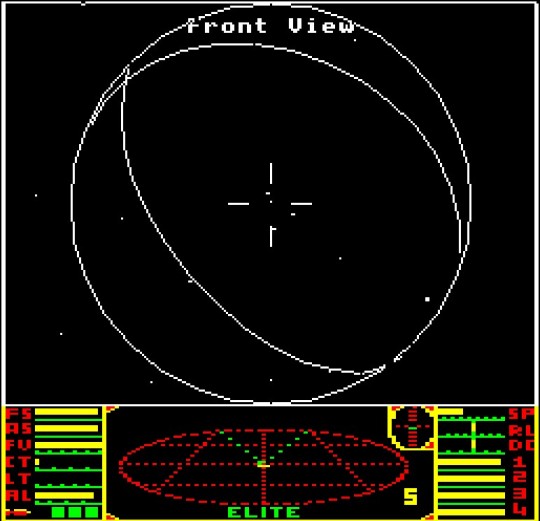
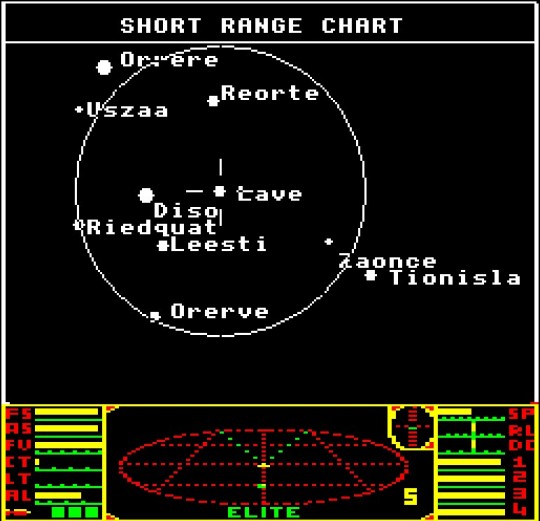
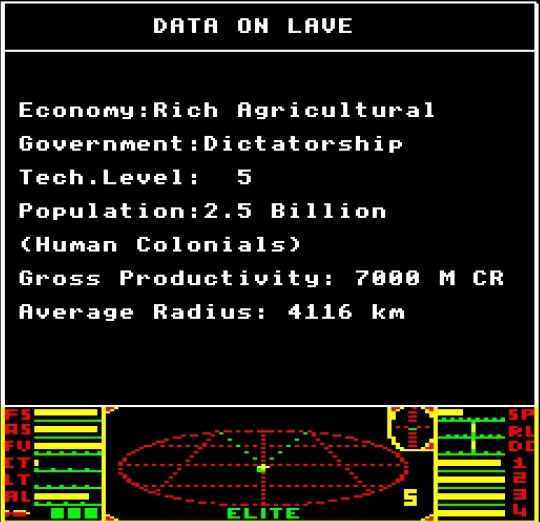



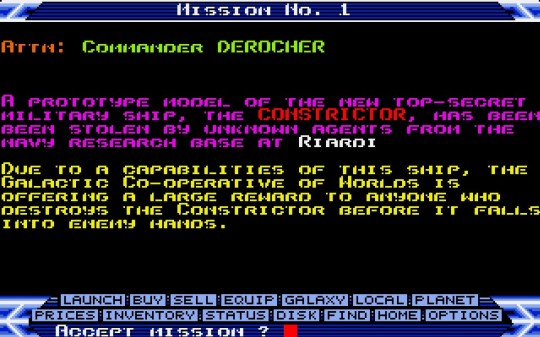

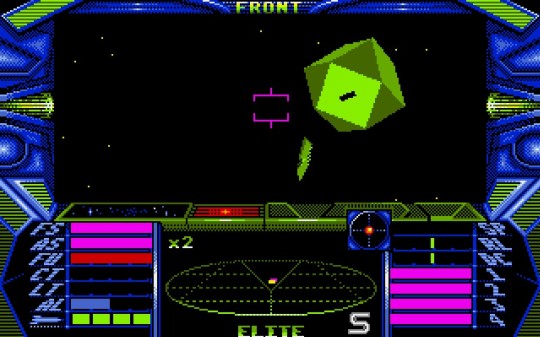
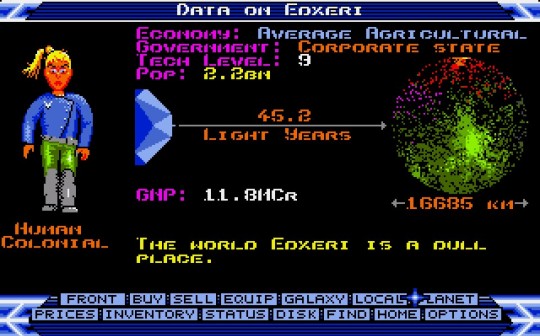
136.) Elite
Release: September 20th, 1984 | GGF: Action-Adventure, Space Sim, Flight Sim, Vehicular Combat, Open World | Developer(s): David Braben, Ian Bell | Publisher(s): Acornsoft Limited, Firebird Software, Superior Software Ltd., Telecomsoft (U.S.), Merlin Software, Rainbird Software, Imagineer Co., Ltd., Hybrid Technology, Digital Integration Ltd., Revelation Software | Platform(s): BBC Micro (1984), Apple II (1985), Commodore 64 (1985), ZX Spectrum (1985), Amstrad CPC (1986), DOS (1987), MSX (1987), Tatung Einstein (1987), Amiga (1988), Atari ST (1988), Acorn 32-bit (1991), NES (1991), SAM Coupe (1996)
0 notes
Photo

Elite 🏢 Acornsoft 📅 1984 🖥 Acorn Archimedes, Acorn Electron, Amiga, Amstrad CPC, Apple II, Atari ST, BBC Microcomputer System, Commodore 64, DOS, MSX...
#Acorn Archimedes#Acorn Electron#Amiga#Amstrad CPC#Apple II#Atari ST#BBC Microcomputer System#Commodore 64#DOS#MSX#NES#Tatung Einstein#ZX Spectrum
0 notes
Text
Research: 1st person cockpit shooter games - Elite
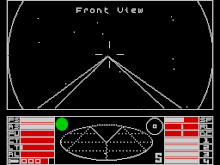
Elite is a old school space combat & trading video game, where the player plays from the cockpit of a ship. It was written and developed by David Braben and Ian Bell and originally published by Acornsoft for the BBC Micro and Acorn Electron computers in September 1984. It’s open-ended game model, and revolutionary 3D graphics at the time led to it being ported to virtually every contemporary home computer system and earned it a place as a classic and a genre maker in gaming history. The game's title derives from one of the player's goals of raising their combat rating to the exalted heights of "Elite".
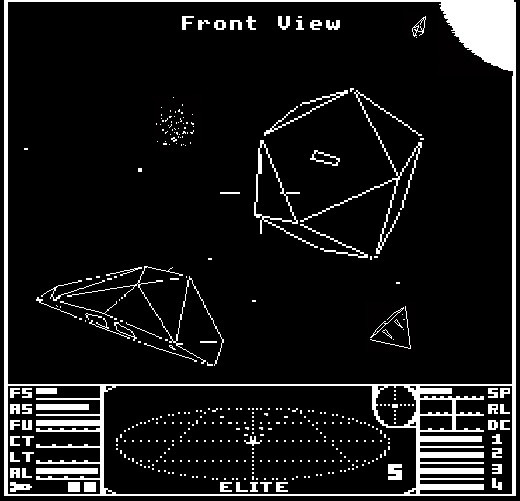
0 notes
Text
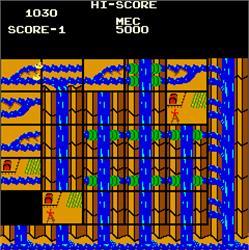
No men or gods, only Qwak. Not to be confused with the lightgun game of the same name, or the Acornsoft platformer of the same name, this is kind of what you'd get if you saved lemmings by playing a tile slider. And if they weren't lemmings, but ducks. And it's not like we ever get any lore regarding the gender of the ducks you're saving.
1 note
·
View note
Photo
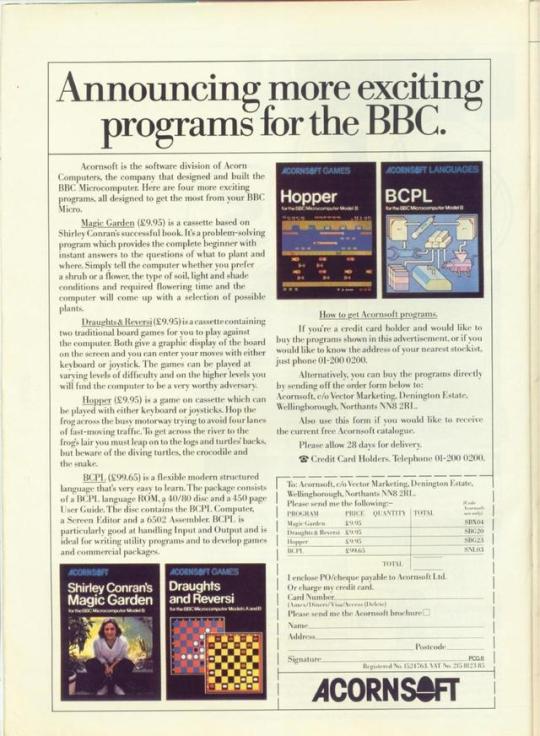
‘Acornsoft - “Announcing more exciting programs for the BBC.”‘
[’BCPL’, ’Draughts and Reversi’, ‘Hopper’, ‘Shirley Conran’s Magic Garden’]
[BBC] [UK] [MAGAZINE] [1983]
Probably the original BBC Software company, this was a software arm of Acorn itself. In my mind, and many others, it is recognised as one of the best. It was particularly good at converting the arcade games of the time (Asteroids, Space Invaders, etc) and it also did a few text adventures which were also good. It is probably best known for the discovery of Elite, and Revs, Geoff Crammonds' first in a long line of successful racing games.
Superior Software eventually came in and bought the whole of Acornsoft's back catalogue in 1986 and from then on some of the games were re-released on the Play It Again Sam, and Acornsoft Hits collections. After five years in the ring it was still the unbeaten champion, and you can imagine why, Acorn had all the knowledge about the beeb, everything which it was capable of, and how to do it in the best way possible, which is why most of their games are extremely well programmed. ~The BBC Games Archive
Source: Personal Computer Games, Summer 1983 (#01) || The Internet Archive; scanned by Jason Scott
#gaming#advertising#acornsoft#bbc micro#draughts#reversi#board games#hopper#action#shirley conran's magic garden#bcpl#programming#computer games#software#1983
4 notes
·
View notes
Text
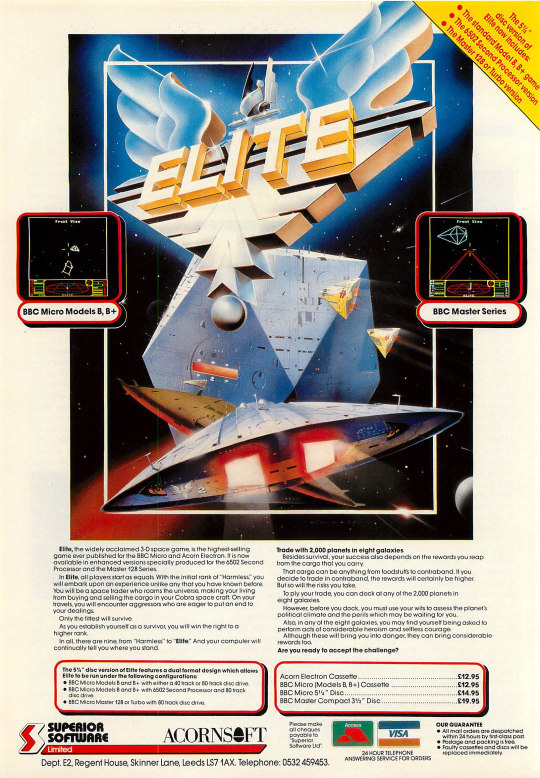
UK 1987
#UK1987#ACORNSOFT#SUPERIOR SOFTWARE#SIMULATION#ACTION#BBC#C64#SPECTRUM#AMSTRAD#APPLE#IBM#AMIGA#ATARIst#MSX#ARCHIMEDES#NES#ELITE
18 notes
·
View notes
Photo
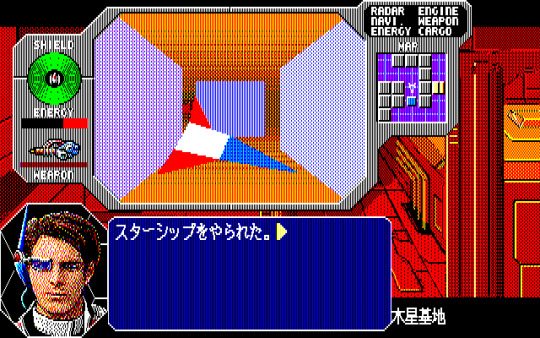
This entry was written for the Japanese Video Game Obscurities book, which is currently being crowdfunded on Unbound. If you want to see this book come to fruition and read about more games like this, please consider pledging! We need your support to make this happen!
Star Cruiser
Star Cruiser is one of the most ambitious computer games of the mid-80s. Developed by Arsys and largely helmed by Kotori Yoshimura, the founder of Technosoft, it’s a sprawling space opera that’s part dungeon crawler, part space simulator, and part role-playing game. In some ways, it’s similar to Western titles like Dynamix’s Stellar 7 and Acornsoft’s Elite, but takes portions of those games and and assembles them into something completely unique. It’s played entirely from a first person perspective, with both the ships and the game world rendered entirely in polygons, an impressive feat for the computers of the the mid-80s. Yoshimura was one of the most talented Japanese programmers of the era, and her 1983 racing game Plasma Line is believed to be one of the first 3D games developed in the country.
Read more...
#hardcore gaming 101#feature#japanese video game obscurities#kurt kalata#star cruiser#arsys#pc games#pc88#pc98#sharp x1#sharp x68000#mega drive#video games#books#literature
9 notes
·
View notes
Text
Game Review : Formula 1 Simulator
Mastertronic / 1985 / Originally £1.99 / ZX Spectrum

A promising start with a Lotus 72 F1 car on the loading and intro screen. Check out the size of the rear tyres on this bad-boy!
For many a small child, the dream of speeding along in a sports car is something of a pipe-dream. Past simple go-karts rented at a track, it becomes horrendously expensive to compete in a sport that has long been the plaything of the rich. Yes, the road to Formula One is paved in gold; yours. How far that road stretches depends on how much gold paving you (or more accurately, your parents) are prepared to lay down.
Even the competitors with the most humble of backgrounds will have made it thanks to a benefactor, be it a company such as Mercedes or individuals whose altruism may hide a burning desire to live out their missed opportunity through another.
Thankfully however, the computer revolution gaves those of us who can't afford the fire-retardant underwear, let alone anything else, the opportunity to give motorsport a go. Back in the early 1980s, games like Chequered Flag from Psion and Geoff Crammond’s Revs from Acornsoft put you in a single seater racing car, providing something of a sense of how it would be to race one around the world’s great circuits.
While these titles cost in excess of £6.95, the budget market was taken care of by Mastertronic whose title, Formula 1 Simulator tried to give you an opportunity to race ten circuits that were part of the Formula 1 season of the time. For modern motorsport fans, the names of the tracks might be familiar but the layouts will not. Much like a Hollywood actor feeling the pressure to look the way they did in their 20s while pushing 50, most circuits have had a lot of work done since 1985; Silverstone or Hockenheim as they are in the game are unrecognisable now. Even tracks that have only subtly changed over the years, like Monza seem radically different.
This however, is not just down to the passage of time; the circuits as they are realised in the game are not all that accurate. Back when Formula 1 Simulator was released, it is unlikely that track research involved taking the time to visit the circuits and capture the kind of information that would really be necessary to make this a detailed simulation. And, to be fair, the expense would not have been recouped in sales.

Monza’s been on the F1 calendar since 1950; it’s a solid place to start with long flowing corners.
The turns are in vaguely the right locations; but as you go round the tracks in your car, it soon becomes clear that even on a good day you and the apex of the corner are never going to get close enough to each other to be friends. Taking any kind of speed into a corner pretty much means trundling around the outside of the corner away from the racing line, no matter how hard you steer in.
Then there’s the exit of the corner. While it's hard to get the car into the corner at speed as you try to put the power down to make quick exit, the car becomes unstable. All too often this results you being flung off the track.
You might be as good as Lewis Hamilton down the kart track of a Thursday night; you might rival Damon Hill round the Tesco’s car-park getting to the last free parking space, or you might even be a credible contender to Nigel Mansell when it comes to passing a Rover 45 round the outside of a roundabout on the A34 to Stoke-on-Trent, but these skills will not help you with Formula 1 Simulator.
Each game starts with you choosing which track you’d like to drive, configuring your car with an automatic or manual gearbox to take you through the five gears and the weather (wet or dry). This is about as much setup variation as you’ll get in Formula 1 Simulator; you don’t even get to select which team you are driving for.

We’re off on a qualifying lap.
From there, it’s a choice between practicing a circuit or racing on it. Practicing doesn’t really add much here - it’s the qualifying for the race that is important. Although you can race, there is no championship to go with it. This really is a disappointing omission, the races feel a little aimless as a result. Mind you, there are times when just getting into the race is a victory in itself...
A race begins with qualifying - complete a lap of the circuit against the clock and you’re into a race. At no point are you told what time you are aiming at, which is a major disadvantage, nor is there any indication of how many laps you have to complete in the race should you get there. Everything here is implicit. You are expected to know that qualifying is a single lap by playing the game enough times.
Once a qualifying lap has been completed, then there is the race. While there are other cars on track to compete against, with no perspective on your rivals other than the graphic of their rear it becomes all too easy to hit them, either ramming into the back of them or unwittingly hitting them when you think you have passed them and resume the racing line. You really might think that this is an exaggeration but seriously, your opponents’ cars all seem to be simultaneously narrower and as wide as your car at the same time.
This game is very unforgiving; any mistake it seems and after a brief message to tell you that you’ve crashed you’ll have to start all over again. This starts to get old very quickly and what’s more, learning the tracks does not seem to make that much of a difference. With the handling of the car the way it is, crashing out feels more like a lottery, rather than down to anything else.

And they’re GO! GO! GO!
Some of Formula 1 Simulator’s shortcomings come from the game having been written with a 16k Spectrum in mind. Unlike a game like Beach-Head on the Commodore 16 where the lameness could have been avoided with some careful consideration and design, many of the problems with the game stem from trying to cram as much realism as you can into such a tiny memory footprint.
Mastertronic certainly took a different approach with the title on the Commodore machines; perhaps it was for the best. While Formula 1 Simulator isn’t going to win any prizes for realism, it should at least be rewarded for being a valiant attempt to try and lever a realistic driving simulator into such a low-spec machine.
Spirit Software and the Kensington CID
Mastertronic’s Formula 1 Simulator was a re-release of a title from another company called Spirit Software who, in 1984 had released the game for the princely sum of £8.95 promising their own steering wheel add-on.
This was quite something for the time; such devices were not really seen outside of the arcades, with games like Sprint or Pole Position having basic wheels and a simple Hi/Low gear shifter.
First versions of the game are alleged to have been sent out with what has been referred to in unflattering terms as a yellow plastic ash-tray that sat on the relevant keys. We’re yet to find a picture of this device in the wild, so it might just be a reference to the instructions in the Mastertronic version that suggested using a Sellotape tin along the keys at the top at the top of the computer.
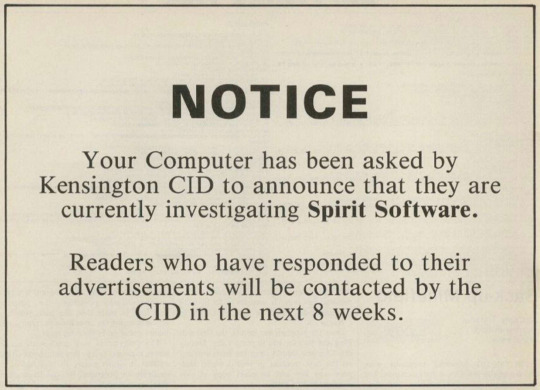
The announcement from June 1984′s Your Computer magazine. [source - archive.org]
Sadly, while the cash for the enterprise readily appeared from Spectrum owners keen to try out the latest fad in games, the hardware did not and by the summer of 1984, Kensington CID (part of London’s Metropolitan Police) were investigating Spirit Software, eventually returning cheques that had not been cashed to those who had been keen to have a more realistic shot at F1 from the comfort of their own homes. Those that had been cashed, well, it seems that money was lost.
What became of the owners of Spirit Software? And more importantly the cash? It’s not entirely clear as the trail of the story dries up with the Police getting involved; presumably the enigmatic author of the game, S.C. Stephens must have sold the game on to Mastertronic, where it became a real money spinner. Across all formats, Formula 1 Simulator sold in excess of half a million copies for its new publisher...
Buying it today
Given it’s a budget title that was available just about everywhere, it’s not in short supply today. If you’re spending £5 including postage you’re spending a lot.
Commentariat
Tim : How I wish this game was different, just a few tweaks here and there could turn this from being a dog of a game into something far more playable.
The steering controls are shocking, and without the ability to change much about the setup of the car (given the release date of the game, this genuinely would be too much to ask), hobbling the game to such an extent that it’s a chore to play. The solution provided by both original developer Spirit and kept by Mastertronic, to have a control mode that needs you to roll - yes roll - a wheel across the top row of a rubber-key Spectrum’s keyboard is as much bizarre, as to how little it is future proof. Fortunately, Mastertronic also added joystick support as well as a more traditional keyboard control option.
After spending more time restarting the game after a crash than actually driving, I just pootled around Monza with automatic gears turned on at a slow speed to get into the race. Manual gears I found impossible due to their poor placing on the keyboard. I had no idea what time I was aiming for to secure pole position, so for all I knew I might be fastest. I wasn’t. Even so, I was in the race, but with no idea how long it would be. I went for it - and crashed right after passing a car.
That was pretty much it for me.
If you can afford to spend memory on a pretty title screen of a Lotus 72, you can afford to improve the in-game data. Or failing that, include a championship mode, or offer team selection, or just about anything from a long list of things that would have been cheap in memory terms, but have added a lot to the game.
With a simulation so poor it’s incredible, but entirely predictable, that Mastertronic stuck with it for the Amstrad and MSX machines instead of converting the far more playable Commodore 64 version.
If you are a driving sim fan, there is only one word for this. Avoid.
Score Lord : Hmmm. I remember this the first time round for all the wrong reasons. While many companies have taken your money and had a liberal interpretation of 28 days delivery when it came to some of their products, their kit usually turned up. Unless it’s a Spectrum Vega+.
I agree that this is hardly a realistic sim but think about what it did for society. First, it no doubt gave people the opportunity to say “I can do better than that” and produce racing titles of their own. Second, it put to bed the idea that an ashtray could be used as a steering wheel once and for all. Saved British Leyland a fortune in R&D, that.
Meat : The day I got my Spectrum, I bought this title. I was already starting to get a feel for motorsport, mostly thanks to an ever-present Nigel Mansell on the TV each Sunday lunchtime in the summer.
My disappointment as a child wasn’t the graphics or the sound, it was that the game was so hard. Even today, I like the way that the car accelerates away with a little chirp from the speaker to mimic wheelspin and that you have to brake properly into the corners. The sad thing was that it wasn’t arcade-y enough in the way it played for me and not simulator-y enough for my Dad. Formula 1 Simulator is kind of an in between sort of game with elements of both but not enough of either to make it work.
After a while I managed to get around the circuit without bouncing off to make it to the race, but when I did, I crashed more or less straight away. This cycle repeated so often I don’t really ever remember finishing a single first lap. I eventually lost interest. Even today, while I can get into the race most of the time, I don’t really want to go any further knowing that I’ll just end up hitting another car.
Due to a minor misunderstanding I was not allowed to try the Sellotape tin steering wheel back in the day, as my father misinterpreted what I intended to do and refused to let me try it out. Without my Dad to tell me otherwise, I’ve tried this as an adult and, yes, it does work but doesn’t make much of a difference. Just makes you look like a weirdo at a gaming expo.
This really seemed to be a game where the developer’s ambition was way beyond the capabilities of the technology at the time, rather than the other way round. Well, that’s how I like to think of it.
Score card
Presentation 4/10
The exciting cover art and well-drawn loading screen soon give way to a lack-lustre menu and garish colours in-game. Good choice of tracks if you had a 48k Spectrum, mind. The steering wheel control method is just, well, odd.
Originality 7/10
At a time when most driving games were top-down sprint-style games or variations on Pole Position, this certainly tried to be different and succeeds.
Graphics 4/10
Middling; the game’s colour palette is horrific, the other cars basic. The track moves nicely, but the sense of speed is diminished with a dearth of roadside objects. Corner markers while present, are so small you easily miss them, making them more or less pointless.
Hookability 2/10
Unfortunately, the game is unrewarding to play mostly because a tiny mistake means it’s all over.
Sound 2/10
While the C64 version had a cool soundtrack courtesy of Rob Hubbard, which also made it onto the Amstrad and MSX conversions, the Spectrum has some basic engine noises and that’s about all. This does add something to the game, but won't win any awards.
Lastability 3/10
Good selection of tracks, even if they are unrealistically modelled, but the unforgiving nature of the game you’d need to be a masochist to keep playing it.
Value for Money 3/10
It was £1.99 at the time of release by Mastertronic, which meant you got a half decent amount of car sim for your money.
Overall 3/10
It’s really difficult to work out if this was a valiant effort that just tried to do too much with too little, or just something that Mastertronic picked up to fill a slot in a software library. Either way though, it’s not good enough to keep you coming back.
0 notes
Photo
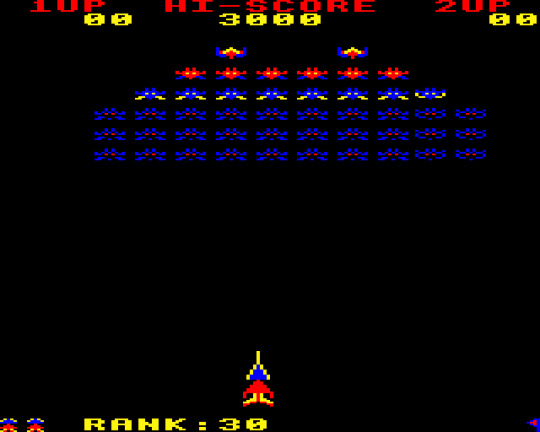
Arcadians is running on BBC Micro and was created by Acornsoft in 1982
Have you played this game ? Go to UVL and add a review to help the other players find the right game!
0 notes
Text
Camiseta Elite '84
Camiseta Elite '84 - Camarada Camisetista. En 1984 comenzó un viaje espacial de exploración galáctica en la Vía Lactea llamado @EliteDangerous #Podcast #Camiseta #CamaradaCamisetista #EliteDangerous
La historia de nuestra camiseta Elite ‘84 comenzó como podéis suponer en 1984.
En ese año Ian Bell y David Braben programaron la versión original de este videojuego para ordenadores BBC Micro y Acorn Electron que fue publicada por Acornsoft.
Fue uno de los primeros videojuegos en utilizar gráficos con ocultación de zonas no visibles en su renderizado wireframe, esto unido a que se…
View On WordPress
0 notes
Text
The Edge of Lore (1990, Virgin; Acornsoft) (Atari ST)
1 note
·
View note
Photo
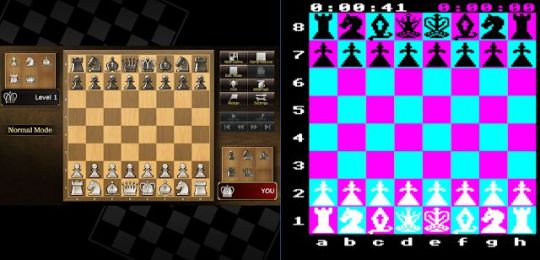
Just Pinned to Brainfood: BBC Micro versus PC at chess If a BBC microcomputer met a Windows 10 PC for a game of chess which machine would win? Let's find out. The contestants: WHITE BBC microcomputer 32KB RAM 2MHz 8 bit 6502 processor Chess engine - Acornsoft Chess BLACK Windows 10 PC 24GB RAM 2.9GHz i7 64 bit Quad-core processor Chess engine - Chess level 100 Chess Level 100 for Windows 10 (on the left playing black) V. Acornsoft Chess for the Beeb (on the right playing white) I decided to start with both machines running on their lowest setting. Acornsoft Chess has ten levels of difficulty whereas Chess Level 100 has erm... one hundred levels of play. The BBC machine was emulated using BeebEm on the Windows PC. I initially set the BBC difficulty to the highest possiblehoweverafter waiting over ten minutes for it to make its opening move I decided to drop the difficulty level for the sake of sanity. Both machines came to a gentleman's agreementthat the Beeb would play white. You can follow the game below or download the PGN file to study on your own system or board. 1. Nf3 h6 Against United Nations security resolutions the Beeb starts with theZukertort Opening keeping its options flexible. The PC responds with a dubious pawn defence. Maybe it doesn't know that there is a war on? 2. d3 d5 3. g3 Nc6 4. Nbd2 Bg4 Already the PC is on the offensive with bishopg4. The Beeb responds with an excellent defence from his own bishop. 5. Bg2 Qd6 6. O-O f5 7. Bh1 b5 8. Nh4 Nf6 9. Rb1 Qe6 PC has an active Queen and is attacking with its pawns. The Beeb is focussed on defence. 10. f3 b4 A superb attacking move from the Beeb threatens the black bishop however the PC makes the dubious pawn advance to b4. It was at this point that I realised that the PC was clearly outmatched by the Beeb. First blood went to the Beeb by capturing the neglected black bishop. 11. fxg4 Nxg4 12. Bf3 Nd4 13. Bxg4 Nxe2 The PC ignores the bishop capture on g4 and sacrifices its knight for a pawn on e2. 14. Bxe2 Qe3 15. Rf2 e5 16. Nxf5 Qc5 17. Bh5 Kd8 18. Bf7 Qc6 19. h3 g5 20. b3 Rc8 21. Qf3 g4 The Beeb's white pieces are beginning to dominate the board as black makes another blunder with the g4 move. 22. hxg4 Be7 23. Qxd5 Qxd5 The Beeb captures the pawn on d5 and forces a swap of queens. It is pretty much all over for the PC now but neither machines offered a ceasation to hostilities. 24. Bxd5 c5 25. Kf1 Rg8 A blunder from the PC puts the black rook in the firing line of the white bishop. Maybe fog of war or otherwise poor intel did not reveal the white bishop lying in wait like a sniper. 26. Bxg8 h5 27. gxh5 c4 28. dxc4 Kd7 29. Nh6 a5 30. Ke1 Rc5 31. Ke2 Rc8 32. Ke3 Bc5 33. Ke4 Bxf2 The PC makes some good play and steals a rook at f2 with probably the only good move it made all game. 34. g4 Be1 35. Bd5 Rh8 36. Nf3 Rxh6 Another blunder from black coming up. The white knight on h6 is too much of a temptation and does not seem to realise it is covered by the white bishop on c1. The Beeb does not let it get away with this mistake. 37. Bxh6 Bf2 38. Kxe5 Kc7 39. Nd4 Bg3 40. Ke6 Bf2 41. Bf4 Kc8 42. Nf3 a4 43. bxa4 Bc5 44. Ng5 Bb6 45. Rxb4 Bc7 The breakthrough is complete. Black's king hides in his underground bunker and denies the reports of his generals that the enemy is massing at the gates. 46. Bb7 Kd8 47. Nf7 Ke8 48. Bxc7 Kf8 49. Bc6 Kg8 50. Bd5 Kf8 51. Nd6 Kg7 52. Ke5 Kh7 53. Nf5 Kh8 Moments before the end black's king has shuffled off into the corner to die. 54. Rb8 Kh7 55. Rb5 Kh8 56. Rc5 Kh7 57. Ke4 Kh8 58. Rc6 Kh7 59. Rh6# White wins. Conclusion So the winner of this battle was the BBC microcomputer running on the emulator. This did come as something of a surprise but it teaches us very little. The Beeb played reasonable chess it did not make any blunders and was both defensive and exploitative of black's errors. The PC running Chess Level 100 on the other hand played very poor chess and was punished for it by the Beeb. It is important to note that both chess engines were playing at their very lowest settings. I am an average ability chess player and I can beat both of these programs with ease on their lowest settings. Clearly the lowest level of Chess Level 100 is designedto be a pretty weak player. If there is any interest in this post then I will maybe follow up with a game where both machines are playing at their very best. Important to note that the Beeb made all its moves in just over 5 minutes at this setting yet it took over ten minutes to make a single move at the highest setting so it won't be a very quick game. If you enjoyed watching this game then you might want to let me know by writing something on the noticeboardor maybe you just want to read some more posts about chess? BBC Micro chess Windows https://ift.tt/2HUStR4
0 notes
